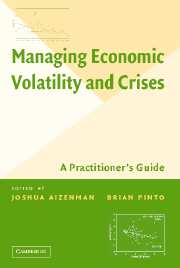Book contents
- Frontmatter
- Contents
- Contributors
- Acknowledgments
- Foreword
- MANAGING ECONOMIC VOLATILITY AND CRISES
- Overview
- PART I WHAT IS VOLATILITY AND WHY DOES IT MATTER?
- 1 Volatility: Definitions and Consequences
- 2 Volatility and Growth
- 3 Volatility, Income Distribution, and Poverty
- PART II COMMODITY PRICES AND VOLATILITY
- PART III FINANCE AND VOLATILITY
- PART IV MANAGING CRISES
- Technical Appendix
- Index
- References
3 - Volatility, Income Distribution, and Poverty
Published online by Cambridge University Press: 25 July 2009
- Frontmatter
- Contents
- Contributors
- Acknowledgments
- Foreword
- MANAGING ECONOMIC VOLATILITY AND CRISES
- Overview
- PART I WHAT IS VOLATILITY AND WHY DOES IT MATTER?
- 1 Volatility: Definitions and Consequences
- 2 Volatility and Growth
- 3 Volatility, Income Distribution, and Poverty
- PART II COMMODITY PRICES AND VOLATILITY
- PART III FINANCE AND VOLATILITY
- PART IV MANAGING CRISES
- Technical Appendix
- Index
- References
Summary
ABSTRACT: This study examines the link between macroeconomic volatility and income distribution, including potential transmission channels. Few cross-country studies have directly examined this link: most have explored either the relation between growth and poverty or between growth and income distribution, and, in some cases, between volatility and growth. Analyzing the volatility–inequality link confronts the well-known challenge of linking the macro- and micro-sides of an economy; this study does not attempt to push the envelope in that direction. Rather, the study uses a cross-country regression framework and finds that output volatility has a negative impact on equality (the income share of the bottom quintile), although this finding is not entirely robust across country groups. The study also finds empirical support for some of the presumed main transmission channels, notably inflation, financial sector depth, and government social security expenditures. Accordingly, the main pro-poor policy responses to volatility or negative income shocks would be to contain inflation, develop financial markets, and ensure countercyclical social security spending. Developing labor markets and establishing well-targeted social safety nets are also key ongoing challenges in this regard, to reduce the vulnerability of low-income groups.
INTRODUCTION
Macroeconomic volatility can affect poverty through its impact on growth as well as its impact on income distribution. Conversely, changes in poverty may be decomposed into a growth effect and an income distribution effect. (See Box 3.1.) Both effects depend on the initial levels of development and income distribution.
- Type
- Chapter
- Information
- Managing Economic Volatility and CrisesA Practitioner's Guide, pp. 101 - 136Publisher: Cambridge University PressPrint publication year: 2005
References
- 26
- Cited by



